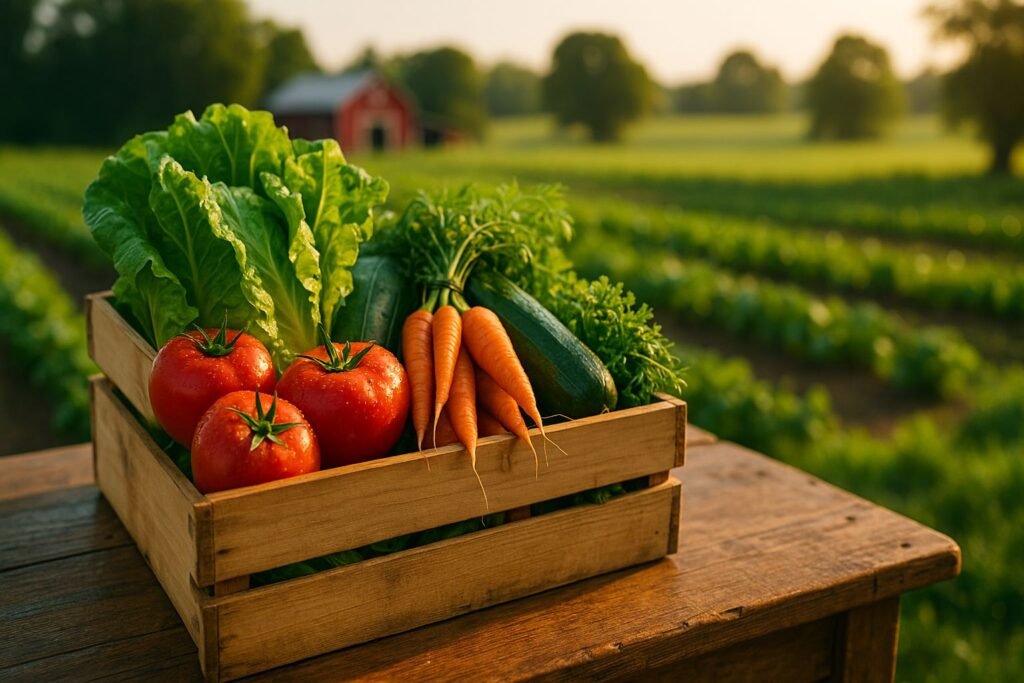Community Supported Agriculture (CSA) is transforming the way small farmers thrive in today’s market. By leveraging CSA revenue models, farmers can secure consistent income, build loyal customer bases, and tap into the growing demand for fresh, local produce. This guide explores proven CSA revenue models, their income potential, and strategies to maximize profitability in 2025.
What is a CSA (Community Supported Agriculture) Model?
Definition and Background
Community Supported Agriculture, commonly known as CSA farming, is a system where consumers subscribe to receive regular deliveries of fresh produce directly from farmers. This subscription farming model fosters a direct-to-consumer relationship, eliminating middlemen and ensuring fresher goods.
History and Evolution
Originating in Japan in the 1960s as “teikei,” the CSA model USA gained traction in the 1980s. Farms like Indian Line Farm in Massachusetts pioneered the concept, which has since spread across Canada, the UK, and beyond. According to the USDA, over 7,000 CSA programs operate in the U.S. alone as of 2023, reflecting its growing appeal (Source: USDA Census of Agriculture).
Core Elements
- Subscription: Customers pay upfront or periodically for a season’s worth of produce.
- Farm Shares: Members receive weekly or monthly shares of crops, often customizable.
- Direct-to-Consumer Sales: Farmers sell directly, retaining higher profit margins.
Why CSA Farming is Gaining Popularity
The rise of the farm-to-table movement has fueled interest in CSA programs. Consumers increasingly value transparency, wanting to know where their food comes from and how it’s grown. This demand for local food delivery CSA options has made CSA a go-to for health-conscious buyers.
For farmers, CSA offers significant benefits:
- Upfront Payments: Secures cash flow before the season begins.
- Customer Loyalty: Builds long-term relationships, reducing marketing costs.
- Community Engagement: Strengthens ties with local consumers.
A 2022 study by the University of California found that 60% of small farmers using CSA models reported higher income stability compared to traditional markets (Source: UC Agriculture). Consequently, CSA is becoming a cornerstone for sustainable farming.
Top CSA Revenue Models That Work in 2025
1. Traditional Subscription Box Model

The CSA box delivery service is the backbone of most CSA programs. Customers receive weekly or monthly boxes filled with seasonal produce, such as vegetables, fruits, or herbs.
Pricing Strategy and Retention Tips:
- Set prices based on local market rates, typically $20–$40 per box.
- Offer flexible subscription lengths (e.g., 12 or 24 weeks) to suit customer needs.
- Include recipes or storage tips to enhance value and reduce churn.
Farm subscription box pricing should balance affordability with profitability. For example, a 2024 survey by LocalHarvest reported that 70% of CSA members prefer customizable boxes, boosting retention by 25% (Source: LocalHarvest).
2. Tiered Membership Models
Offering profitable CSA model options like Basic and Premium shares allows farmers to cater to diverse budgets. Basic shares might include staple vegetables, while Premium shares add high-value items like berries or greens.
Upsell Opportunities:
- Include add-ons like eggs, honey, or flowers to increase recurring revenue farming.
- Example: A $25 Basic share vs. a $45 Premium share with add-ons can double per-customer revenue.
This model’s flexibility appeals to urban families and foodies alike, driving higher engagement.
3. Work-Share CSA
In a CSA member share system, customers pay lower subscription fees in exchange for volunteering on the farm. This reduces labor costs while fostering community involvement.
Benefits:
- Cuts labor expenses by up to 30%, per a 2023 farm study (Source: Farm Journal).
- Builds a loyal customer base through hands-on experiences.
For instance, a small farm might offer a 50% discount on shares for 4 hours of weekly volunteer work, attracting budget-conscious members.
4. Online CSA with Home Delivery
Tech-savvy farmers are tapping into direct-to-consumer farm sales by offering online CSA platforms with home delivery. Urban customers value convenience, making this model highly scalable.
Tools and Platforms:
- Use CSA delivery software like Farmigo or Harvie to streamline orders and logistics.
- Partner with local delivery services to reach city dwellers.
A 2024 report by AgFunder noted that online CSA programs grew by 40% in urban areas, driven by seamless logistics (Source: AgFunder).
5. Farm-to-Restaurant Partnerships
The farm-to-table business model thrives on supplying local restaurants with weekly produce. Farmers secure contracts to deliver consistent, high-quality goods, ensuring steady revenue.
Implementation:
- Negotiate contracts with 3–5 restaurants for predictable income.
- Offer exclusive items like microgreens to command premium prices.
This model suits farmers with diverse crops and reliable production capacity.
How Much Income Can You Generate with CSA?
CSA revenue models often outperform traditional market sales due to their predictable cash flow. A small-scale CSA farm with 50 members can generate $30,000–$50,000 annually, compared to $20,000 from traditional markets, per a 2023 study by Sustainable Agriculture Research (Source: SARE).
Income Forecast by Model:
| CSA Model | Avg Members | Avg Income/Month | Upsell Potential |
|---|---|---|---|
| Basic Subscription | 50 | $4,000 | Low |
| Tiered Membership | 70 | $6,200 | High |
| Farm-to-Restaurant | 3–5 contracts | $7,000+ | Medium |
The CSA income potential varies by scale and model. For instance, make money farming small scale is achievable with just 1–2 acres, as tiered models and add-ons boost sustainable farm income.
Marketing Strategies to Grow Your CSA Revenue
Effective CSA marketing strategies are key to attracting and retaining members:
- Local SEO & Social Media: Optimize your website for keywords like “local CSA near me” and share farm updates on Instagram or Facebook.
- Email Marketing: Send newsletters with harvest updates and renewal reminders to improve customer retention CSA.
- Referral Programs: Offer discounts for members who refer new subscribers.
Testimonials from happy customers can increase sign-ups by 20%, according to a 2024 marketing study (Source: HubSpot).
Common Challenges and How to Overcome Them
CSA farming problems can hinder success, but proactive strategies help:
- Crop Planning and Delivery Consistency: Use crop rotation and succession planting to ensure steady supply. Software like Tend can aid planning.
- Customer Churn: Offer flexible subscriptions and excellent customer service to retain members.
- Logistics & Weather Risks: Invest in backup delivery systems and crop insurance to mitigate subscription farming risk.
A 2023 survey found that 65% of CSA farmers cited weather as their top challenge, but diversified crops reduced losses by 40% (Source: ATTRA).
Is CSA Right for Your Farm?
CSA suits farms of all sizes, but consider:
- Ideal Farm Size: 1–5 acres can support 50–100 members.
- Type of Crops: Focus on seasonal, high-demand crops like tomatoes, lettuce, and herbs.
- Time Commitment: Expect 20–30 hours weekly for management and delivery.
Small backyard farms can start with 10–20 members to test the model.
Final Thoughts: Why CSA is the Future of Farm Income
CSA revenue models offer scalability, stability, and environmental benefits. By fostering direct consumer relationships, farmers reduce reliance on volatile markets. The social impact—supporting local economies and sustainable practices—makes CSA a win-win. With long-term profitability in sight, CSA is poised to redefine small-scale farming.
While CSA programs offer a steady income stream, combining them with smart crop choices can boost overall farm profitability.
👉 Learn more in our post on Top 10 Most Profitable Crops to Grow in Small Farms, where we explore the best crops to grow for maximum return.
FAQs About CSA Revenue Models
How much can you earn from a CSA farm?
A small CSA with 50 members can generate $30,000–$50,000 annually, depending on pricing and model (Source: SARE).
What is the most profitable CSA model?
Tiered membership models often yield the highest returns due to upselling opportunities.
Can CSA work for small backyard farms?
Yes, even 0.5-acre farms can support 10–20 members with high-value crops.
How do you price a CSA subscription box?
Price boxes at $20–$40 based on local rates, ensuring costs cover production and delivery.
